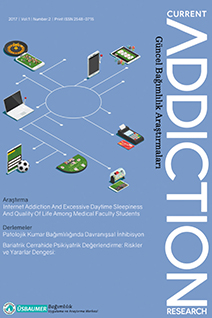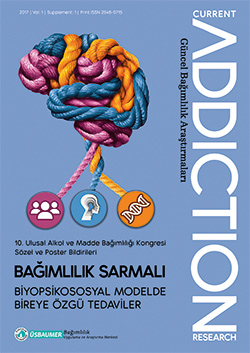Years
2021
2020
2018
2017
Categories
Authors
- Ahmet Yılmaz (1)
- Alptekin ÇETİN (1)
- Alptekin Çetin (1)
- Altunışık Toplu Sibel (1)
- Birgül Cumurcu Hatice (1)
- Bolat Kaya Özlem (1)
- Cemal Onur Noyan (2)
- Cihat Paltun Salih (1)
- Erol Göka (1)
- Fagan Zakirov (1)
- Filiz Özsoy (1)
- Gül ERYILMAZ (1)
- Gül Eryılmaz (1)
- Hasan Kaya (2)
- Işıl Göğcegöz (1)
- Mustafa Akan (1)
- Müberra Kulu (1)
- Salih Cihat Paltun (1)
- Şafak Yalçın Şahiner (1)
ARTICLES
Case Report
Are there any connections between kleptomania and addiction?
Gül ERYILMAZ,Alptekin ÇETİN
2021, 5(2), s:33-34
Kleptomania is a clinical condition in which the desire to steal different objects cannot be inhibited regardless of value. It is classified as “impulse control disorder” in DSM 5. A 24-year-old patient with alcohol use disorder developed kleptomania after successful treatment. In this case, kleptomania can also be evaluated from the perspective of addiction.
Case Report
Multidisciplinary Approach to Naltrexon Implant Related Local Complications: Case Report
Mustafa Akan,Altunışık Toplu Sibel,Birgül Cumurcu Hatice
2020, 4(1), s:28-34
Case Report
Müberra Kulu,Filiz Özsoy
2020, 4(1), s:35-39
The association of alcohol /substance use disorder and attention deficit hyperactivity disorder (ADHD) is a frequently reported condition. The comorbidity of these two diseases both compromises treatment compliance and increases mortality and morbidity rates. The medical treatments used in ADHD treatment are also very limited due to their potential for abuse. In this case report, the regression of attention deficit symptoms and improvement in the neuropsychometric tests due to atomoxetine treatment in opiate use disorder patient will be presented.
Case Report
Gambling Disorder Following Bariatric Surgery
Gül Eryılmaz,Cemal Onur Noyan
2018, 2(2), s:62-63
Pathological gambling is defined as persistent and repetitive gambling behaviors, characterized by the inability to control the gambling behavior of the individual, family or professional functionality. It is stated that the possibility of occurrence of alcohol and substance use disorders is increased after obesity operations, which have been frequently applied in recent years. Until now, gambling disorder, which is considered as impulse control disorder, is evaluated under the category of addiction behaviors with DSM-5. In this case report, the case of gambling disorder following bariatric surgery will be discussed.
Case Report
Respiratory Depression caused by Buprenorphine and Benzodiazepine Use
Hasan Kaya,Bolat Kaya Özlem,Cihat Paltun Salih
2018, 2(1), s:22-26
Buprenorphine is a semi-synthetic opioid derived from thebaine. It is used for analgesic effect and opioid substitution therapy. In Turkey, buprenorphine and naloxone combination (Suboxone®) has been used in opioid substitution therapy since 2010. In this paper respiratory depression arising after buprenorphine use together with benzodiazepine will be told and possible mechanisms of this interaction will be discussed.
Case Report
Primary-Secondary Differentiation of Substance Use Disorders and Psychosis Association: Case Report
Işıl Göğcegöz,Fagan Zakirov
2018, 2(1), s:27-30
Psychoactive substance use disorder can be defined as a chronic illness with an uncontrollable impulsivity to drug use by affecting reward, motivation, memory and decision making mechanisms in individuals brains. These substances can cause dangerous consequences in the lives of individuals by causing addiction and, on the other hand, by stimulating or depressing the central nervous system, causing mood, mental state, behavioral and motor function disorders. Caffeine, hallucinogens, lysergic acid diethylamide (LSD), inhalants, nicotine, phencyclidine, sedatives, hypnotics, anxiolytics, anabolic steroids, nitrous oxide are among the addictive substances (1 ,2). The incidence of psychiatric disorders in patients with substance use disorders is 2.7 times higher. It has been reported that 70-75% of individuals with substance use disorders are accompanied by at least one psychiatric disorder (2,3). It is also known that substance abuse is more common in psychiatric disorders. In a study conducted in Turkey psychoactive substance use in schizophrenia 3.2%, while bipolar disorder is reported to be 3.5%. In the same study, 39% of the patients who received substance abuse and inpatient treatment received psychotic disorder and 23% received bipolar disorder (4).
Very common psychotic disorder or comorbid condition among substance use related disorders is clinically important. One of the biggest challenges faced by clinicians in this case is the primary-secondary distinction (5). In this study, psychoactive substance use and psychosis association and primary-secondary distinction are discussed through two case studies.
Case Report
NALTREKSON CİLT ALTI İMPLANT UYGULAMASI SONRASI GELİŞEN CİLT REAKSİYONU
Salih Cihat Paltun,Şafak Yalçın Şahiner,Hasan Kaya,Erol Göka
2017, 1(2), s:72-72
Naltrexone subcutaneous implants are among the new alternatives in the treatment of alcohol and opioid addictions in our country.Nausea, vomitting, headache, skin rash, depression, anxiety and loss of energy are side effects reported in the use of naltrexone. This paper discusses a case of itching and skin eruptions following the application of naltrexone subcutaneous implant.
Case Report
“TILL PETHIDINE DO US APART”; ADDICTED HEALTHCARE PROFESSIONAL COUPLE
Alptekin Çetin,Ahmet Yılmaz,Cemal Onur Noyan
2017, 1(2), s:75-77
Pethidine(Meperidine) is a synthetic opioid analgesic of the phenylpiperidine class. Since 1940ies, addictive potential of pethidine was documented in many reports. Pethidine addiction is also common among medical doctors and nurses. We present clinical features and treatment response of a married couple, a gastroenterologist and a nurse who were admitted with pethidine addiction. A 34-year-old male(a gastroenterologist) and a 26-year-old female(a nurse) married couple were admitted to clinic with the use of pethidine intravenously. While male patient refused treatment, female patient continued her treatment in inpatient service. Healthcare professionals have to be cautious while using and prescribing drugs with addiction potential. Surgeons, anesthesiologists, gastroenterologists psychiatrists and surgical nurses are the risk groups for dependency among those professionals.



 2. Sayı
2. Sayı
 1. Sayı
1. Sayı
 Ek Sayı
Ek Sayı







